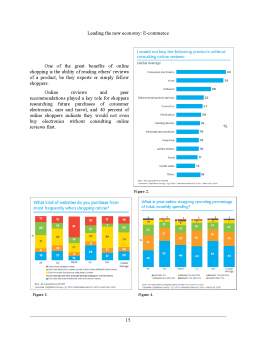Cuprins
- Chapter 1. Introduction page 1
- Chapter 2. Types of e-commerce page 5
- 2.1. B2B
- 2.2. B2C
- 2.3. C2C
- Chapter 3. Payment systems page 11
- 3.1. PayPal vs Google Checkout
- Chapter 4. Business applications page
- Chapter 5. Online shopping page
- 5.1. Advantages and disadvantages
- 5.2. Global trends in online shopping
- 5.3. Online shopping survey
- 5.4. Where is online shopping heading to?
- Chapter 6. Concerns about shopping online page
- Chapter 7. Conclusions page
- Chapter 8. References page
Extras din proiect
1. Introduction
In the context of the emerging new economy, e-commerce has become very often a crucial element of business strategy and the basis for economic development. Relationships within organizations and those between and among organizations and individuals have been changed for the better due to the integration of information and communications technology (ICT) in business. More precisely, the use of ICT in business has enhanced productivity, encouraged greater customer participation, and enabled mass customization, besides reducing costs.
E-commerce was seen as a fad or a gimmick when the pioneers of the process appeared. One of the prevailing problems of the early-line transactions was the security of personal financial information. This brought about the debut of data encryption. Thus, the possibilities for businesses expanded as more and more companies started to operate online in what may be presented as a global fashion. Now, business is no longer bound to a city or a region, it can be conducted anywhere without hindrances. All together, this indicates a strong trend in shopping patterns and purchasing decisions of consumers.
What exactly is electronic commerce?
E-commerce is the process of buying and selling goods and services electronically with computerized business transactions using electronic systems such as the Internet or other computer networks. It also encompasses activities supporting those market transactions, such as advertising, marketing, customer support, delivery and payment.
While the volume of e-commerce as a percentage of the nation’s GNI is growing at an increasing rate, the nature of e-commerce is getting more complex as the market evolves. There are at least three major forces fueling e-commerce:
Economic forces. One of the most evident benefits of e-commerce is economic efficiency resulting from the reduction in communications costs, low-cost technological infrastructure, speedier and more economic electronic transactions with suppliers, lower global information sharing and advertising costs, and cheaper customer service alternatives.
Economic integration is either external or internal. External integration refers to the electronic networking of corporations, suppliers, customers/clients, and independent contractors into one community communicating in a virtual environment (with the Internet as medium). Internal integration, on the other hand, is the networking of the various departments within a corporation, and of business operations and processes. This allows critical business information to be stored in a digital form that can be retrieved instantly and transmitted electronically. Internal integration is best exemplified by corporate intranets. Among the companies with efficient corporate intranets are Procter and Gamble, IBM, Nestle and Intel.
Market forces. Corporations are encouraged to use e-commerce in marketing and promotion to capture international markets, both big and small. The Internet is likewise used as a medium for enhanced customer service and support. It is a lot easier for companies to provide their target consumers with more detailed product and service information using the Internet.
Technology forces. The development of ICT (information and communications technology) is a key factor in the growth of e-commerce. For instance, technological advances in digitizing content, compression and the promotion of open systems technology have paved the way for the convergence of communication services into one single platform. This in turn has made communication more efficient, faster, easier, and more economical as the need to set up separate networks for telephone services, television broadcast, cable television, and Internet access is eliminated. From the standpoint of firms/businesses and consumers, having only one information provider means lower communications costs.
Preview document
Conținut arhivă zip
- Leading the New Economy - E-Commerce.doc































